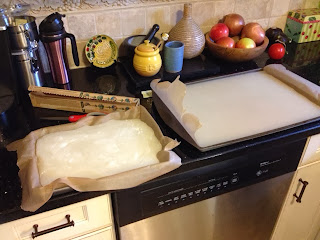For the past two years I have used a hive top feeder. The first year I noticed an unsettling amount of bee drownings, but otherwise I liked the easy access for the bees afforded by the hive top feeder. Then last year I experienced a similar unsettling amount of drownings, but it was also compounded with a really gross hive beetle infestation. I had a disturbing amount of hive beetle larvae showing up in the feeder - which was really gross and also difficult to get under control.
No mas. Behold the creative contraption invented by my handy man husband:
This is essentially the jar feeder method with some added perks. We did a lot of investigation as to whether to poke the holes in the jar inward or outward. I confirmed that my BANV notes on the subject from last year said to poke the holes from the inside of the jar going outward. If I was listening correctly, the idea is that the bees can navigate around the sharp edges they can see - but if the holes are poked from the outside going inward, then they cut themselves when they drink. Unfortunately, we became confused when we found conflicting information on the subject online. The solution? Poke the holes any way you want and sand down all of the sharp edges so there's no risk to the bees. Dude, we seriously put in a lot of effort on this gadget. And by we, I mean my husband Brian who did the entire thing. All I did was pull out my BANV notes from last year...
The entire frame rests inside an empty hive body, set immediately above the bees. The bees have easy access and placing the jars inside the hive body means less risk of robbing. An added benefit is that the jars slide in and out for refill without having to smoke the bees too often, meaning we can refill the jars without disrupting the hive. Another benefit is that we lose MUCH less sugar water to evaporation, and NO bee drownings. My singular concern is that the several holes providing access for the bees may not be sufficient to adequately feed an entire healthy colony. We have been monitoring their intake, however, and it seems normal enough. We are replacing one jar every 7-10 days or so I think which seems about right.
I have to give full credit to the spouse for design, creation, and implementation. I'm not entirely sure what I brought to the process, but I think I'll claim inspiration.




